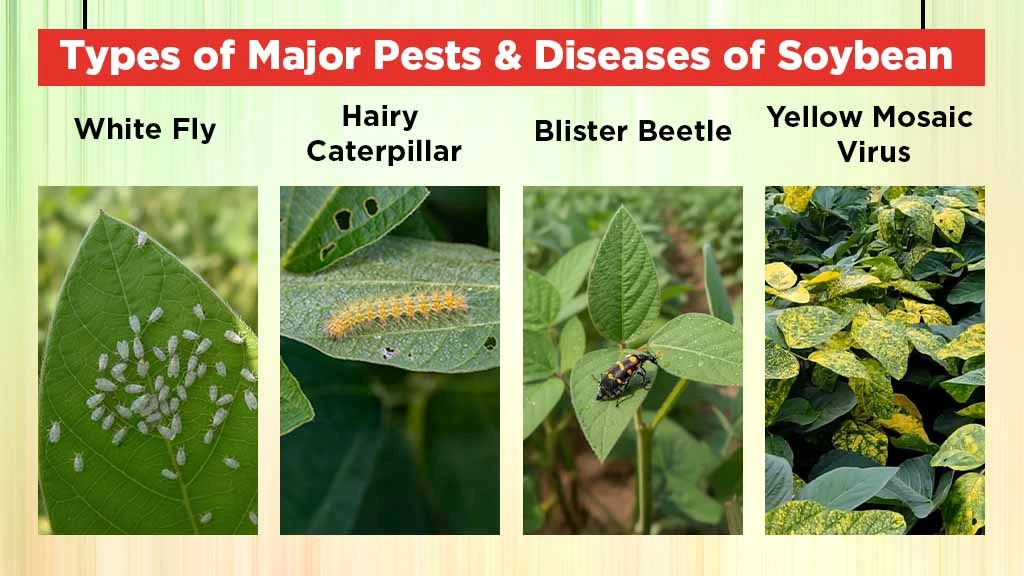Soybean Farming in India: Cultivation, Varieties & Major Producing States

Soybean is a highly nutritive and healthy legume which has an immense economic value in India. It is the largest source of vegetable seed oil and protein and has turned out to be the major oilseed crop in India. Today’s blog explores the complete cultivation process of soybean crop along with its varieties and major producing states in India.
Table of Contents
- Soybean Farming in India: An Overview
- Which are the Major Soybean Varieties found in India?
- What is the Cultivation Process of Soybean in India?
- Major Soybean Producing States in India
Soybean Farming in India: An Overview
Soybean is a staple crop, comes from the legume family. It is also known as “Golden Beans” due to its colour and shape. It was originated in East Asia. Its scientific name is Glycine max and belongs to the family Fabaceae. Due to its rich protein and fibre content; it is a vital source for human and animal consumption. In domestic and international markets, it has a growing demand due to which farmers in India get higher returns from its cultivation.
Which are the Top 10 Soybean Varieties found in India?
- PS 1347
- SL 688
- MACS-1188
- JS-20-29
- JS-20-34
- NRC-86 (ahilya-6)
- Raj Soya-24
- KPS-344
- NRC-77
- Pant Soy-24
What is the Cultivation Process of Soybean in India?
Soil & climate, land preparation, planting, fertilizer application, weed management, etc. are the major steps of soybean cultivation. Let’s understand each in more detail below.
Soil & Climate
Soybeans grow best in well drained, fertile loamy soils. The ideal pH for the optimum yield of soybean is 6 to 7.5. Waterlogged and saline/alkaline soils are not suitable for its cultivation. Soybean requires a temperature between 18°C to 38°C with 30 cm to 60 cm rainfall. The crop is very sensitive to low temperatures.
Land Preparation
Prepare the field by giving two to three rounds of ploughing followed by planking and make beds and channels to achieve best results in soybean production.
Seed Rate & Treatment
25 to 30 kg seeds are required for sowing in one acre of land. Treat them with Thiram or Captan @ 3 gm per kg of seeds to protect them from soil borne diseases.
Sowing
As it is a Kharif crop, the best time for sowing Soybean is mid-June. Sow the seeds using a seed drill at a depth of 2 - 3 cm adopting a spacing of 30 cm X 5 cm.
Fertilizer Application
Ideally, always apply fertilizer according to the soil test reports. If the soil report is not available, adopt blanket recommendation of 20:40:20:20 NPKS kg/ha, if adequate moisture is available.
Weed Management
Alachlor may be applied to the irrigated crop at 4 litres/ha or Pendimethalin 3.3 litre/ha after sowing followed by one hand weeding 30 days after sowing.
Irrigation
Three to four irrigations are required for the soybean crop. Irrigation at time of pod filling stage is most critical. In good rainfall conditions, no irrigation is needed.
Pest & Disease Management

|
Pest & Disease |
Symptoms |
Control Measures |
|
White Fly |
Yellowing of leaves, leaf curling, etc. |
Spray Thiamethoxam @40 gm or Triazophos @300 ml/acre. If necessary, take second spray 10 days after first spray. |
|
Hairy Caterpillar |
Brownish-yellow leaves |
Spray Quinalphos @300 ml or Dichlorvos @200 ml/acre. |
|
Blister Beetle |
Grain formation leads to the damage of flowers, buds and leaves. |
spray of Indoxacarb 14.5SC@200 ml or Acephate 75SC@800 gm/acre. |
|
Yellow Mosaic Virus |
Irregular yellow or green patches on leaves. |
Spray Thiamethoxam @40 gm, Triazophos @ 400 ml/acre. If necessary, take second spray 10 days after first spray. |
Harvesting
The harvesting process usually takes 7-10 days after the crop turns yellow. Once the crop becomes yellow and start shedding, it means the crop is ready to harvest. Harvest the crop with sickle or by hand. After soya bean harvesting, carry out threshing operation.
Major Soybean Producing States in India
As per Soybean Outlook 2024, the total Soybean production in India is 115.28 lakh tonnes as compared to 149.85 lakh tonnes in 2022-23. The major soybean producing states of India are:
|
Major Soybean Producing States |
Total Production (in lakh tonnes) |
|
Maharashtra |
45.74 |
|
Rajasthan |
10.69 |
|
Karnataka |
4.73 |
|
Gujarat |
4.23 |
|
Telangana |
2.90 |
As we have seen that, due to its dietary benefits, the demand of soybean has been increasing day by day in Indian states, we can clearly say that this is a pathway which leads to sustainability and economic growth of the country. With proper measures and government support, farmers can get higher yields and better income with soybean cultivation.
Frequently Asked Questions On Soybean Farming in India: Cultivation, Varieties & Major Producing States
1. Is soybean farming profitable in India?
Yes, soybean farming is profitable in India as it gives higher yields and better income to farmers.
2. Which state is the largest producer of soybean in India?
Maharashtra is the largest producer of soybean in India with 45.74 lakh tonnes total production.
3. How much soyabean can be grown in 1 acre?
25 to 30 kg soyabean seeds are required for sowing in one acre of land.
4. How are Soya chunks made?
Soy chunks are made of soy flour, which is a by-product of soy oil extraction.
5. Which is the soybean capital of India?
Madhya Pradesh is known as the soybean capital of India.
6. Who is the biggest consumer of soybeans?
China is the biggest consumer of soybeans in the world.
7. What climate is best for soybeans?
Warm and moist climate with a temperature between 18°C to 38°C with 30 cm to 60 cm rainfall is optimum for soybean cultivation.


Related Blogs












